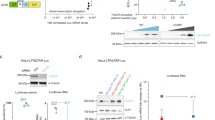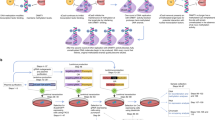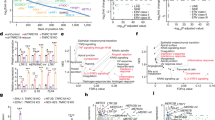Abstract
Transcriptional silencing, one of the major impediments to gene therapy in humans, is often accompanied by replication during late S-phase. We report that transcriptional silencing and late replication were prevented by DNA sequences that can initiate DNA replication (replicators). When replicators were included in silencing-prone transgenes, they did not undergo transcriptional silencing, replicated early and maintained histone acetylation patterns characteristic of euchromatin. A mutant replicator, which could not initiate replication, could not prevent gene silencing and replicated late when included in identical transgenes and inserted at identical locations. These observations suggest that replicators introduce epigenetic chromatin changes that facilitate initiation of DNA replication and affect gene silencing. Inclusion of functional replicators in gene therapy vectors may provide a tool for stabilizing gene expression patterns.
This is a preview of subscription content, access via your institution
Access options
Subscribe to this journal
Receive 12 print issues and online access
$209.00 per year
only $17.42 per issue
Buy this article
- Purchase on Springer Link
- Instant access to full article PDF
Prices may be subject to local taxes which are calculated during checkout




Similar content being viewed by others
Accession codes
References
Gilbert, D.M. Replication timing and transcriptional control: beyond cause and effect. Curr. Opin. Cell Biol. 14, 377–383 (2002).
Azuara, V. et al. Heritable gene silencing in lymphocytes delays chromatid resolution without affecting the timing of DNA replication. Nat. Cell Biol. 5, 668–674 (2003).
Simon, I. et al. Developmental regulation of DNA replication timing at the human beta globin locus. EMBO J. 20, 6150–6157 (2001).
Dhar, V., Skoultchi, A.I. & Schildkraut, C.L. Activation and repression of a beta-globin gene in cell hybrids is accompanied by a shift in its temporal replication. Mol. Cell. Biol. 9, 3524–3532 (1989).
Ermakova, O.V. et al. Evidence that a single replication fork proceeds from early to late replicating domains in the IgH locus in a non-B cell line. Mol. Cell 3, 321–330 (1999).
Mostoslavsky, R. et al. Asynchronous replication and allelic exclusion in the immune system. Nature 414, 221–225 (2001).
Wutz, A. & Jaenisch, R. A shift from reversible to irreversible X inactivation is triggered during ES cell differentiation. Mol. Cell 5, 695–705 (2000).
Lin, C.M., Fu, H., Martinovsky, M., Bouhassira, E. & Aladjem, M.I. Dynamic alterations of replication timing in mammalian cells. Curr. Biol. 13, 1019–1028 (2003).
Feng, Y.Q. et al. The human beta-globin locus control region can silence as well as activate gene expression. Mol. Cell. Biol. 25, 3864–3874 (2005).
Feng, Y.Q., Lorincz, M.C., Fiering, S., Greally, J.M. & Bouhassira, E.E. Position effects are influenced by the orientation of a transgene with respect to flanking chromatin. Mol. Cell. Biol. 21, 298–309 (2001).
Aladjem, M.I. et al. Participation of the human beta-globin locus control region in initiation of DNA replication. Science 270, 815–819 (1995).
Kalejta, R.F. et al. Distal sequences, but not ori-beta/OBR-1, are essential for initiation of DNA replication in the Chinese hamster DHFR origin. Mol. Cell 2, 797–806 (1998).
Wang, L. et al. The human beta-globin replication initiation region consists of two modular independent replicators. Mol. Cell. Biol. 24, 3373–3386 (2004).
Kitsberg, D., Selig, S., Keshet, I. & Cedar, H. Replication structure of the human beta-globin gene domain. Nature 366, 588–590 (1993).
Epner, E., Forrester, W.C. & Groudine, M. Asynchronous DNA replication within the human beta-globin gene locus. Proc. Natl. Acad. Sci. USA 85, 8081–8085 (1988).
Aladjem, M., Rodewald, L.-W., Kolman, J.L. & Wahl, G.M. Genetic dissection of a mammalian replicator in the human beta-globin locus. Science 281, 1005–1009 (1998).
Paixao, S. et al. Modular structure of the human lamin B2 replicator. Mol. Cell. Biol. 24, 2958–2967 (2004).
Aladjem, M.I. & Fanning, E. The replicon revisited: an old model learns new tricks in metazoan chromosomes. EMBO Rep. 5, 686–691 (2004).
Kim, C.G., Epner, E.M., Forrester, W.C. & Groudine, M. Inactivation of the human beta-globin gene by targeted insertion into the beta-globin locus control region. Genes Dev. 6, 928–938 (1992).
Saha, S., Shan, Y., Mesner, L.D. & Hamlin, J.L. The promoter of the Chinese hamster ovary dihydrofolate reductase gene regulates the activity of the local origin and helps define its boundaries. Genes Dev. 18, 397–410 (2004).
Ghosh, M., Liu, G., Randall, G., Bevington, J. & Leffak, M. Transcription factor binding and induced transcription alter chromosomal c-myc replicator activity. Mol. Cell. Biol. 24, 10193–10207 (2004).
Aggarwal, B.D. & Calvi, B.R. Chromatin regulates origin activity in Drosophila follicle cells. Nature 430, 372–376 (2004).
Danis, E. et al. Specification of a DNA replication origin by a transcription complex. Nat. Cell Biol. 6, 721–730 (2004).
Zhou, J. et al. The origin of a developmentally regulated Igh replicon is located near the border of regulatory domains for Igh replication and expression. Proc. Natl. Acad. Sci. USA 99, 13693–13698 (2002).
Ellis, J. Silencing and variegation of gammaretrovirus and lentivirus vectors. Hum. Gene Ther. 16, 1241–1246 (2005).
Bestor, T.H. Gene silencing as a threat to the success of gene therapy. J. Clin. Invest. 105, 409–411 (2000).
Yao, S. et al. Retrovirus silencing, variegation, extinction, and memory are controlled by a dynamic interplay of multiple epigenetic modifications. Mol. Ther. 10, 27–36 (2004).
Lorincz, M.C., Schubeler, D. & Groudine, M. Methylation-mediated proviral silencing is associated with MeCP2 recruitment and localized histone H3 deacetylation. Mol. Cell. Biol. 21, 7913–7922 (2001).
Ellis, J. & Pannell, D. The beta-globin locus control region versus gene therapy vectors: a struggle for expression. Clin. Genet. 59, 17–24 (2001).
Lorincz, M.C., Schubeler, D., Hutchinson, S.R., Dickerson, D.R. & Groudine, M. DNA methylation density influences the stability of an epigenetic imprint and Dnmt3a/b-independent de novo methylation. Mol. Cell. Biol. 22, 7572–7580 (2002).
Mutskov, V. & Felsenfeld, G. Silencing of transgene transcription precedes methylation of promoter DNA and histone H3 lysine 9. EMBO J. 23, 138–149 (2004).
Aladjem, M.I. et al. Replication initiation patterns in the beta-globin loci of totipotent and differentiated murine cells: evidence for multiple initiation regions. Mol. Cell. Biol. 22, 442–452 (2002).
Bielinsky, A.K. & Gerbi, S.A. Discrete start sites for DNA synthesis in the yeast ARS1 origin. Science 279, 95–98 (1998).
Kobayashi, T., Rein, T. & DePamphilis, M.L. Identification of primary initiation sites for DNA replication in the hamster dihydrofolate reductase gene initiation zone. Mol. Cell. Biol. 18, 3266–3277 (1998).
Forsberg, E.C. et al. Developmentally dynamic histone acetylation pattern of a tissue-specific chromatin domain. Proc. Natl. Acad. Sci. USA 97, 14494–14499 (2000).
Acknowledgements
We thank Barbara J. Taylor, FACS Core Facility, Center for Cancer Research (CCR), National Cancer Institute (NCI), National Institutes of Health (NIH), for expert help with cell sorting experiments, Joseph O. Lopriaeto and Carla Valenzuela for help with plasmid construction, Kurt W. Kohn, Yves G. Pommier, William M. Bonner and Sohyoung Kim for critical reading of the manuscript, and James Ellis, Mel DePamphilis, Carl Schildkraut, Tal Kafri, Chava Kimchi-Zarfaty, Tsutomu Shimura, Jung-Hyun Kim and Elliot Epner for helpful discussions. This study was supported by the Intramural Research Program of the NIH, NCI, CCR (M.I.A.), by NIH grants R01 DK56845, P01 HL55435 (E.E.B.) and by the Howard Hughes Medical Institute/Montgomery County Public Schools internship program (S.S.).
Author information
Authors and Affiliations
Corresponding author
Ethics declarations
Competing interests
The authors declare no competing financial interests.
Supplementary information
Supplementary Fig. 1
Time course of GFP expression of transgenes inserted into the RL4 site. (PDF 403 kb)
Supplementary Fig. 2
Replicators can prevent gene silencing at a the RL5 site on chromosome 4. (PDF 338 kb)
Supplementary Table 1
Primers and probes used in this study (PDF 99 kb)
Rights and permissions
About this article
Cite this article
Fu, H., Wang, L., Lin, CM. et al. Preventing gene silencing with human replicators. Nat Biotechnol 24, 572–576 (2006). https://doi.org/10.1038/nbt1202
Received:
Accepted:
Published:
Issue Date:
DOI: https://doi.org/10.1038/nbt1202
This article is cited by
-
Order from clutter: selective interactions at mammalian replication origins
Nature Reviews Genetics (2017)
-
Distinct epigenetic features of differentiation-regulated replication origins
Epigenetics & Chromatin (2016)
-
A replicator-specific binding protein essential for site-specific initiation of DNA replication in mammalian cells
Nature Communications (2016)
-
High-resolution analysis with novel cell-surface markers identifies routes to iPS cells
Nature (2013)
-
Rif1 choreographs DNA replication timing
The EMBO Journal (2012)



